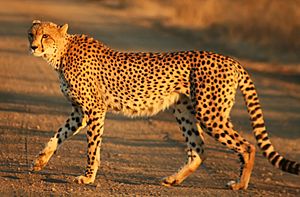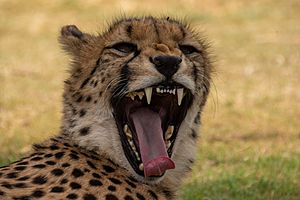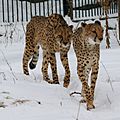Southeast African cheetah facts for kids
Quick facts for kids South African Cheetah |
|
|---|---|
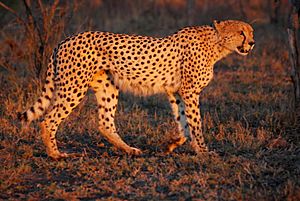 |
|
| A South African Cheetah from Hluhluwe-Umfolozi Game Reserve, South Africa. | |
| Conservation status | |
| Scientific classification | |
| Kingdom: | |
| Phylum: | |
| Class: | |
| Order: | |
| Family: | |
| Genus: | |
| Species: | |
| Subspecies: |
A. j. jubatus
|
| Trinomial name | |
| Acinonyx jubatus jubatus (Schreber, 1775)
|
|
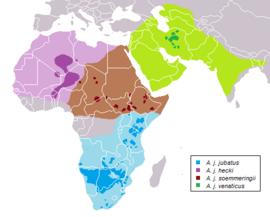 |
|
| A. j. jubatus range (blue) | |
| Synonyms | |
|
Acinonyx jubatus lanea |
|
The South African Cheetah (Acinonyx jubatus jubatus), also known as Namibian Cheetah, is the nominate subspecies of cheetah native to Southern Africa. It is the most abundant subspecies estimated at more than 6,000 individuals in the wild. Since 1990 and onwards, the population was estimated at approximately 2,500 individuals in Namibia, until 2015, the cheetah population has been increased to more than 3,500 in the country.
The South African Cheetah is the closest relative to the two other distinct subspecies, the Asiatic Cheetahs and the Northeast African Cheetah.
Physical characteristics
The cheetah is a medium-sized cat. An adult male cheetah's total size can measure from 168 to 200 cm (66 to 79 in) and 162 to 213 cm (64 to 84 in) for females. Adult cheetahs are 70 to 90 cm (28 to 35 in) tall at the shoulder. Males are slightly taller than females and have slightly bigger heads with wider incisors and longer mandibles.
Measurements taken of wild cheetahs in Namibia indicate that the females range in head-and-body length from 113 to 140 cm (44 to 55 in) with 59.5-to-73.0 cm (23.4-to-28.7 in) long tails, and weigh between 21.0 and 63.0 kg (46.3 and 138.9 lb); males range in head-and-body length from 113 to 136 cm (44 to 54 in) with 60-to-84 cm (24-to-33 in) long tails, and weigh between 28.5 and 65.0 kg (62.8 and 143.3 lb).
The cheetah has a bright yellow or sometimes a golden coat, and its fur is slightly thicker than that of other subspecies. The white underside is very distinct, especially on the neck and breast, and it has less spotting on its belly. The spots on the face are more pronounced, and as a whole its spots seem more dense than those of most other subspecies. The tear marks are notably thicker at the corners of the mouth, and almost all of them have distinct brown mustache markings. Like the Asiatic cheetah, it is known to have fur behind its tail and have both white and black tips at the end of its tail. However, the cheetah may also have only a black tip at the end of its tail.
In desert areas, such as the Kalahari, cheetahs are somewhat smaller and lighter in weight, with thinner, bright-colored fur, a trait the Northwest African cheetah also has.
Images for kids
-
An illustration of a cheetah cub (Acinonyx jubatus guttata) by Joseph Wolf in the Proceedings of the Zoological Society of London, 1867
-
The Southeast African cheetah was one of the most widespread animals. These two cheetahs were photographed at southwestern South Africa between 1906 and 1918.
-
A cheetah suffocating an impala in Timbavati, South Africa
-
An orphan cheetah set to be reintroduced to Victoria Falls, Zimbabwe
-
Two captive cheetahs in Nehru Zoological Park, India. The Asiatic cheetah, which used to inhabit India, is extinct there.
-
A cheetah in Cincinnati Zoo and Botanical Garden, Ohio, the United States of America
-
Cheetahs and other captive animals are able to live in cold climate, as demonstrated by these cheetahs at Tiergarten Schönbrunn, Austria
-
A cheetah silhouetted against a fiery sunset in Okavango Delta, Botswana
-
At Farm Achalm in Namibia
See also
 In Spanish: Guepardo sudafricano para niños
In Spanish: Guepardo sudafricano para niños



